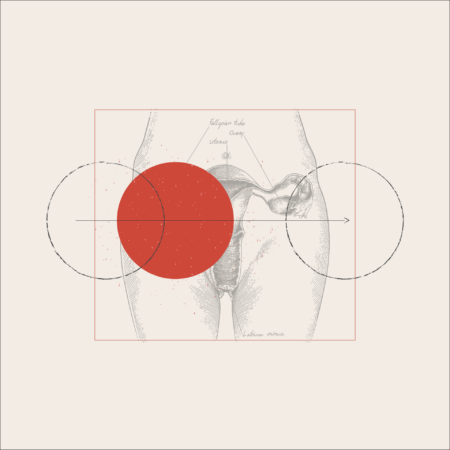Though women have been menstruating since before homosapiens were fully evolved as a species, it wasn’t until the 19th century that scientists linked periods to ovulation. Ancient societies associated periods with witchcraft, postulating that the blood could stop hailstorms, kill crop yields, and cure leprosy, if they wrote about menstruation at all. As late as the 1920s, medical professionals believed periods regulated female emotions and tempers, and were disconnected from them physiologically, infecting them monthly like a cold.
Narratives like this have placed the female form on a pedestal where it has been admired, suspected for its arcane qualities, and kept in the shadow of ignorance. Given that histories are recorded and circumstances dictated by men, it’s not surprising that women (expressed here as both female-identifying people and people with wombs) found it harder than men to have their bodies defined in the medical sphere. As Simone de Beauvoir describes in The Second Sex: “Representation of the world, like the world itself, is the work of men; they describe it from their own point of view, which they confuse with absolute truth.” Centuries on, and the liminal nature of the female body has become so ingrained that even now we do not have a scientific grasp on it.
Many female specific ailments, like endometriosis, polycystic ovary syndrome (PCOS), premenstrual dysphoric disorder (PMDD), and vaginismus are woefully under-researched, with their causes and treatments unknown. Women are constantly misdiagnosed and mistreated by both male and female physicians, and the lack of institutional drive to curb this trend is yet another sign of the taboo around female bodies.

The gender health care gap is both a national and an international issue—whilst healthcare is administered locally, medical research that informs clinical guidelines and standards of care is conducted globally. As women’s issues continue to be swept under the rug worldwide (everything from female pleasure and period health to menopause and postpartum depression), unconscious bias will continue to plague medical training and practice. The fight to bring women’s healthcare to the fore begins with discourse: active consciousness about these issues and their normalization. Luckily, significant inroads towards building infrastructure in women’s health are being made in the burgeoning field of femtech. Many female-led businesses are helping to close the care gap by incorporating the female perspective into their operating core and user experience—helping women with everything from simple medical tasks like tracking periods to innovations in hormone biomarker diagnostics.
Still, despite the global women’s health market projecting to reach $41.05 billion by 2027, women in fem-tech face an uphill battle. The amount of funding to women-led startups declined to just 2.3 percent in 2020, with the average size of a VC deal for all-female teams being $6.8 million compared to $18.7 million for all-male founded teams. This is compounded by a reduction of women cited in scientific research during the pandemic, with several studies showing that the burden of constant childcare has led to a drop in papers published and clinical trials led by women in the past year.
It has never been more crucial to keep the issue of women’s health on the forefront of the equality agenda. Only by understanding the history of parochial subjugation of the female body can we begin to understand the structures of prejudice that underpin our healthcare and health science infrastructure today, and work towards dismantling the roadblocks that continue to hinder female innovators.
Girl, interrupted
To understand how the male body became the default human construction, we have to go back to the 15th and 16th centuries when biology was first meaningfully applied to humans. In order to study our biology, European physicians used to employ grave robbers to exhume recently entombed cadavers, or steal dead bodies from the gallows for dissection. The corpses they brought back became the basis of the earliest understanding of how we move, bleed, digest, think, and feel. However, female hormonal fluctuations were considered too deviant to make consistent calculations, and so these bodies were, of course, always male. Maleness became the model by which medications were developed, and its effects on people studied.
Centuries later, masculinity is still the industry standard. Learning from male bodies is frequently the default in clinical trials today, where subjects are overwhelmingly men—even the standard laboratory mice are male. Indeed, it was only recently that gender-based differences were acknowledged as an important factor in medicine at all. In 2001, the Institute of Medicine published what was considered a revolutionary study entitled “Exploring the Biological Contributions to Human Health: Does Sex Matter?”, concluding that sex should be recognized as an important variable in research, and that increased knowledge in this area should be cultivated, more than 250 years after the first modern clinical trial was conducted.
However, women continue to be woefully under-represented in practical medical research. The U.S. National Library of Medicine, which funds and helps coordinate medical research nationwide, has admitted it has yet to produce guidelines on recommended study design that takes into account the sex or gender of participants. (They promise they’re “working on it”.)
It’s not hard to see how this overwhelming bias towards the male subject becomes incredibly restrictive to women hoping to access proper medical care. If medicine’s blueprint is male-sex-based, then the only options available to women in terms of treatment are functionally potluck.
Even the standard laboratory mice are male.
The range of remedies arbitrarily thrown at women throughout history reads like a Doctor Seuss advice column. Women were told to swallow toads to ease heavy menstrual flow, had hemp and corn forced up their vaginas to induce labour, and were advised to marry and bear children early in life to avoid their womb (thought by the ancient Greeks to have a mind of its own) dislodging and gliding freely about their body.
‘Hysteria’, a word first coined in the 5th Century BC, was a common medical diagnosis for women from as far back as Ancient Egypt to as recently as Freud, and was attached to women displaying all manner of symptoms from shortness of breath and fainting to insomnia and fluid retention. It was as much a catch-all term for physicians as a form of social control: a bad case of hysteria was attributed to women who had sex outside of marriage, displayed an attraction to the same sex, or violated any of the myriad patriarchal social mores of the time, often to secure their place in an asylum and away from society’s prying eyes (some famous examples include Elizabeth Packard and Zelda Fitzgerald).
Though ‘hysteria’ is no longer a legitimate medical diagnosis, many decades later there remains a worrying trend of mass invalidation when it comes to women and the healthcare system. Research by McGill University has found that doctors assume women to be both more emotionally volatile and have a higher pain threshold than men. This means that they are far more likely to have medical professionals report their pain as “emotional”, “psychogenic”, and “not real” according to Harvard Medical School.
Indeed, women’s bodies have always been inherently linked with pain. Childbirth, PMS, and menopause are par for the course of life—often considered part of ‘womanly duties’—and convention has been content to shrug off that pain as exaggerated, or worse, normal; dismissed with the adage that being a woman inherently hurts. A 2019 study of the U.S. healthcare system revealed that when in pain, men are more likely to be given painkillers, while women are more likely to be given antidepressants or even sedatives, a literal enactment of patriarchal attempts to silence a woman’s problem akin to the medieval ascetic “women should be seen but not heard” school of thought.

In fields as diverse as brain cancer, chronic pain, and dementia, it can take women up to seven times longer than male patients to receive a diagnosis. This lack of ability, or even desire, to take a woman at her word predictably leads to high rates of misdiagnosis and delayed care.
A 2018 study by the American Heart Association found that men were 6 percent more likely to receive bystander CPR when suffering from an apparent heart attack in a public setting than women, resulting in 29 percent increased odds of survival. Similar research from the British Heart Foundation revealed that women who suffer heart attacks are half as likely as men to receive the recommended medical treatment for cardiovascular issues—for instance, only 15 percent of female heart attack patients were fitted with a stent, compared to 34 percent of men. This follows other recent research by the BHF which found that more than 8,000 women in England and Wales had died of misdiagnosed or untreated heart attacks they had tried to report over a ten-year period.
Despite this evidence, the American Heart Association has concluded that the likely reason women experience a higher mortality rate from cardiovascular issues is because these issues present wildly differently in the female body than the standard male model, with female heart attacks featuring “less obstructive plaque” than the male-bodied heart, requiring alternative treatments such as suctioning out blood clots. The AHA tepidly states that “more research” is needed in this area to draw firm data, seemingly overlooking the fact that said research is entirely within its own mandate. No such research appears to be forthcoming.
“The health gender gap is fed by perceptions of women being over-emotional and exaggerating the extent of their pain and suffering,” states women’s health specialist Dr Larisa Corda. “In reality, many women under-report symptoms… If they’re not taken seriously when they do see a doctor, it propagates the notion that whatever they’re going through isn’t serious, which can have massive implications.”
In 2019, there were 1,003 studies related to male sexual performance compared to 178 studies dedicated to female infertility.
If women are losing the battle in the arena of general medicine, they are even more hamstrung in the field of women-specific illnesses. Endometriosis, a painful, cancer-like disease which causes cells to grow haphazardly around the uterus and affects one in ten women, has remained a mystery to doctors since it was discovered in 1860. Across the board, less than 2.5 percent of publicly funded medical research has been dedicated exclusively to female reproductive health disorders, despite the fact that one third of women will experience severe reproductive health issues in their lifetime according to Modern Fertility. There has been five times the amount of research into male erectile dysfunction, which afflicts just 19 percent of men, than into premenstrual syndrome, which affects 90 percent of women. In 2019 alone, there were 1,003 studies related to male sexual performance compared to 178 studies dedicated to female infertility.
Dig even deeper and you’ll find further imbalances: Black women are five times more likely than white women to die in childbirth, LGBTQIA+ people are more likely to suffer physical and mental health issues than their cis peers, and there is almost no working research currently being done on how medical treatments affect trans bodies, including the long-term effects of hormone therapy.
All of this matters, and matters deeply. Doctors can’t help patients if they don’t have enough information, and without a proper diagnosis, patients can’t make informed decisions about their health. To return to Beauvoir and The Second Sex, “The body is not a thing, it is a situation: it is our grasp on the world and our sketch of our project”.
Enmeshed in our corporeal selves, our bodies are how we interact with and experience the world phenomenologically; what’s more, we typically internalize our view of ourselves under the gaze of others. The project of feminism is to detach femininity and women’s physical selves from the dominant gaze of another, but this cannot be achieved if each time a female body breaks down it must be assessed and cured under the male purview.
Search for a cure
Neuroscientists have found that unconscious bias is ingrained in us from a very early age. And, like everything else, medical training is taught in a way that affirms pre-existing prejudices, regardless of the gender of the trainee. On the whole, it’s reasonable to assume that healthcare professionals are compassionate people who entered their field due to a desire to help others. But even the most egalitarian practitioner will provide siloed care if working from a data set constructed around a single type of patient—that is, the white cis male.
As Dr Rebecca Shansky, a neuroscientist at Northeastern University in Boston, told The Guardian, “People like to think they’re being objective and uninfluenced by stereotypes but there are some unconscious biases that have been applied to how we think about female… research subjects”.
Our brains tend to cluster people into groups for cognitive ease, so that we can process information faster. This is a useful evolutionary tool on the whole—it was easier for our ancestors to react to “big teeth” and “large claws” than to calculate accurate threat metrics for an approaching lion, for example—but can become a destructive force in something as nuanced as medicine. If a patient’s symptoms don’t fall into the expected pattern—one built on data from already gender biased studies—then the chances of a health condition being recognized decreases, and those who are under-represented in medical research, like women and people of color, can easily be swept into the wrong pot.
There are those who hail med-tech as the next frontier in patient treatment, and the answer to humanity’s prejudice problem. Theoretically, AI could relieve pressure on healthcare services, and create a more level playing field when it comes to diagnostics and treatment. An AI-integrated healthcare system would be able to avoid many of the pitfalls of fallible, biased humanity. But, unfortunately, one of the decade’s best examples of a medical service extrapolating seemingly sound conclusions from biased data sets (ultimately leading to a biased and therefore wrong conclusion) came from an algorithm. The healthcare app Babylon was discovered to be doling out vastly different medical advice regarding chest pain to men and women. The system had advised a 60-year-old male smoker reporting sudden chest pains and nausea to go to the emergency room with a suspected heart attack. However, a woman who input exactly the same information was told she was likely having a panic attack. (As previously mentioned, women are more likely to die from a heart attack than men, by a factor of 50 percent.)
Babylon, whose founder is male, made calculations based on male-centric studies. Hence, the AI ran into the same problem that all non-human intelligences inevitably must: it can only put out what we put in, and, if all we can put in is our bias, we’ll get bias back.
We’re only just beginning to gather the data needed to reverse tracks at a systemic level, but it’s clear that the imbalance of perspective in the medical science field at large is hamstringing attempts to close the healthcare gap. It’s for this reason that women-led startups, which are creating equitable solutions to the lack of female-centric data, are so crucial.
Broadening the field
The issue of a gender imbalance in the decision-making echelons of healthcare is an endemic one. Consulting firm Oliver Wyman found that, in 2019, women comprised only 33 percent of senior leadership among healthcare providers and insurers despite making up 65 percent of the healthcare workforce and 80 percent of healthcare consumers.
The gulf that exists between women attempting to understand and look after their bodies and the men in leadership positions who dictate the manner in which they do this was tragicomically exemplified in early 2021 by two men in Germany who pitched a new women’s health product on the reality show Dragon’s Den (think Europe’s Shark Tank). The merchandise, called Pink Gloves, consisted of a disposable plastic glove designed to “hygienically” remove tampons and menstrual products. It was, of course, pointlessly gendered a baby pink with a ‘girly’ love-heart embossed ostentatiously on its front. The product, which includes a plethora of problematic, stigmatic undertones entrenching stereotypes about “unclean” periods (as well as committing fairly obvious acts of environmental vandalism by creating entirely unnecessary disposable plastic) was given full financial backing by male Dragon and business tycoon Ralph Klinnert to the tune of 30,000 Euros.
The image of these three men shaking hands on an entirely arbitrary and wrong-headed women’s health product was a microcosm of the sad state of med-tech entrepreneurship, and entrepreneurship more broadly, where there’s been a substantial drop in funding for women-led start-ups. It bears repeating here that VC funding to female-led new businesses in the U.S. fell to an all time low of 2.3 percent in 2020.
Maleness became the model by which medications were developed, and its effects on people studied.
Whilst the pandemic has put further forks in the road for the funding and development of women’s health innovation, many are still banking on the industry’s bright future as we emerge from quarantine with a renewed need for at-home tests and treatments. Indeed, already in the pipeline of newly backed startups is the development of a ‘smart’ tampon that helps diagnose endometriosis and a 3D-printed hollow breast implant for mastectomy patients.
In 2021 we’ve come far in talking about social injustices, but healthcare is lagging behind. “We’ve only started to look at these gender differences over the past decade,” says Dr Sanne Peters, a research fellow in epidemiology at the University of Oxford’s George Institute, who is currently researching inconsistencies between male and female access to treatment for heart conditions. “There’s a problem in terms of awareness that there are issues, and also in terms of our knowledge of what’s causing them—whether they’re down to biological factors that put women at a higher risk, or gaps in treatment caused by bias.”
To change the unconscious biases often at work when we visit our family doctor or walk into an appointment with a specialist, however, more effort and awareness is needed at the training level. “Medical misogyny is more widely known than ever before, but tackling it needs to be a priority from the start of doctors’ careers,” says Peters. “It starts with listening to women, not assuming they’re hysterical.” Whilst this acknowledgement can come in many different forms, it’s hard to think of a more ideal model for “listening to women” than investing in women-founded healthcare startups that are doing just that, such as Folx Health, Health in Her Hue, Tia, and Mahmee.
Certainly, there are times when your doctor is right—it is just stress. But even the allegedly high rates of stress and anxiety in women could be chalked up to centuries of forced confoundment with our own bodies. Women have been taught to recognize themselves as vessels, at once too corporeal and too emotional, but never before as merely flesh and blood; profane objects in need of tuning just like our male counterparts. Structurally, women must be re-embodied.





